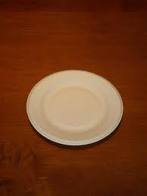Ingredients:
-
-
+ For garlic knots: crushed garlic cloves + melted butter
+ some more milk for brushing
Directions:
Proof the yeast by stirring it vigorously with warm water and sugar in a small bowl (water ca. 37-45 degrees Celsius). Cover the bowl with a towel and leave it for up to 10 minutes until it has a frothy top.
Mix the yeast with all ingredients other than the flour. Sift in the flower while mixing - making sure you don’t work the dough too hard or too long or you will struggle to make it rise later. Cover bowl with towel and leave in a warm place (no drafts) to rise to twice its original size. Rule of thumb is to leave it to rise for max 3 hours. If it still hasn’t risen your yeast was probably “dead” before you started or you used too hot water to proof it thereby “killing” it. Divide dough into about 25-35 pieces depending on preferred size.
Roll each piece into to a smooth bun shape. Sometimes we make them into knots instead of plain rolls by rolling strips of dough and folding them into a knot (see photo below). For a flavourful twist, we sometimes flatten the the strips with a rolling pin and spread a mix of garlic and butter on them using a brush. Then we roll up the strips and shape them into knots again (see photo).
Place rolls/knots on a greased or non-stick baking sheet. We like when the rolls/knots batch or rise to touch each other so place them quite close together. Cover with a towel. Preheat oven to 250 degrees Celsius. For second rising, leave them for at least 30 minutes in a warm place (no drafts). Brush the rolls with room-temperature milk and bake in the middle of the oven for 8-10 minutes until light brown.
Enjoy, and keep in mind that these can be frozen for future enjoyment…
Photos:
Spreading garlic/butter mix on dough - before tying them in knots!
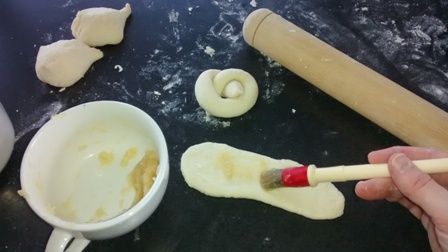
The only knots left the next day…
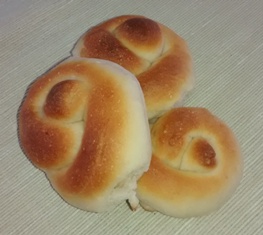
This weekend we wanted to have a ploughman’s lunch in stead of dinner. We were trying to save space for Thanksgiving-level eating the rest of the weekend (Happy Thanksgiving, Canada!). Our neighbour brought the cheese and wine and we supplied a range of cold sandwich meats, smoked salmon, and various vegetables. The final item was bread…. so why not make a damper, we thought. We dug out the first damper recipe we got while living in Australia. It isn’t very authentic as the stockmen in the outback would not have carted around potatoes, butter or Italian herbs. It is also unlikely that they would have had access to milking cows. How about milking camels? (ho-hum):
Ingredients (size = 25 cm diameter):
- 1 cup mashed potatoes
- 3 cups self raising flour (or add baking powder to plain flour)
- 2 tablespoons Italian herbs (f.ex. mix of dried oregano, basil, garlic, bell peppers, onion, salt, sugar)
- 1/4 teaspoon salt (unless there is salt in the herb mixture)
- 1/2 teaspoon pepper (unless there is pepper in the herb mixture)
- 2 teaspoons butter/margarine (maybe use this to make the mashed potatoes?)
- 1/2 cup of skim milk
Directions:
Preheat oven to 220 degrees Celsius. Mix flour, herbs, salt, and pepper. If you didn’t use butter/margarine to make the mashed potatoes, use your hands to rub the butter/margarine into the flour mixture. Stir in the mashed potatoes and enough skim milk to make a sticky dough. Use hands to knead the dough until it is smooth. We often make it round and cut two 1.5 cm deep cuts in it to divide the loaf into 8 pieces before baking.
Bake at 220 degrees Celsius for 10 minutes. Turn down the temperature to 180 degrees Celsius. It is a good idea to let the hot air out to cool the oven quicker. Bake for 30-35 minutes. Tap the bottom of the loaf. It is done if it sounds hollow. Let the loaf rest before cutting. Cut into wedges and serve - for example with a ploughman’s lunch.
Here is a before photo:
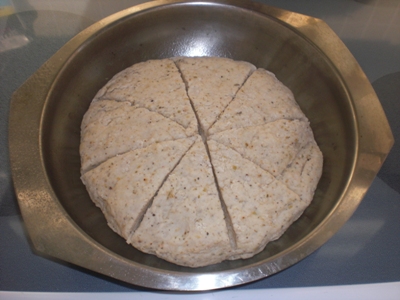
And as usual we forgot to take the after photo and there was only one small wedge left:
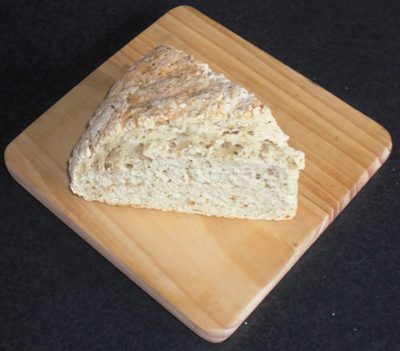
Another recipe from Janet’s (mum’s) collection. 10-øreskaker (with the current exchange rate to Canadian Dollars) translates to 2-cent cakes. This is not the cost of making or buying them anymore! Some may call them a sweet buttermilk scones. But I don’t know quite what to call them in English. Rest assured that they are delicious, and freeze well to be defrosted quickly in the microwave for that sudden urge for something sweet with your cup of tea or coffee or mug of milk.
Ingredients (120 cakes… so I often make half of this)
- 500 grams butter
- 1 litre butter milk
- 500 grams syrup (corn syrup worked well)
- 50 grams ammonium bicarbonate (sometimes sold as “harts horn” or in Norway - “hjortetakksalt”)
- 700 grams sugar
- ca. 1 litre plain flour
Directions
Preheat oven to 220 degrees celsius. Mix milk, melted butter and warm syrup. Add the dry ingredients. Add flour gradually until the dough is firm enough to be rolled with a rolling pin. Use a glass or a large cookie cutter to cut the cakes from the rolled-out dough. We choose a smaller glass to make the cakes more to our preferred snack-size (see photo). Put on baking sheet above the middle of the oven and bake for 7-9 minutes. Leave cakes to cool down. Serve as is or with a bit of butter/spread and maybe even a slice of Jarlsberg cheese brunost (goat cheese sometimes sold in North America as “Skiqueen”) and/or jam. Nam Nam.
Note that we have struggled to find ammonium bicarbonate outside Europe, but yesterday we stumbled across it in one of the Loblaws grocery shops here in Ottawa. It is sold in a small 30 gram plastic container with screw-top lid and our excuse is that it was partially hidden behind a large box of baking soda. In desperation we have in fact tried to make 10-øreskaker using baking soda and baking powder, but they don’t produce that nice fluffy middle, and there is often a not so charming taste of baking soda. Be warned that baking with ammonium bicarbonate does NOT make for a yummy dough to nibble before baking (bummer) - and it makes for smelly fumes in the kitchen so keep your windows open. Also, don’t open the oven door and stick your head too close to check out how they are doing… the fumes are quite unpleasant. Luckily the smell dissipates quickly leaving only delicious fluffy snacks. Enjoy!
Photo 1: Cutting the cakes
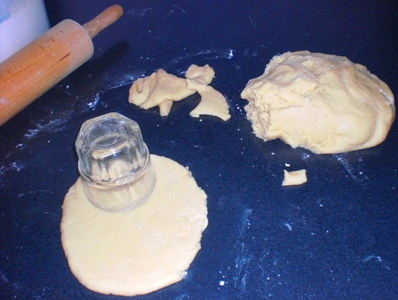
Photo 2: Ready for snacking!
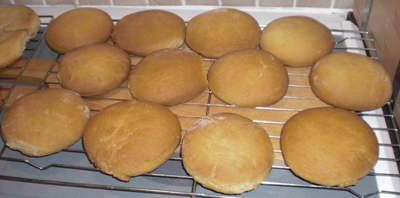
Ingredients - dough:
-
60 grams yeast (or one bag of dried yeast)
-
500 grams plain flour
-
1/2 teaspoon ground cardamomme
-
90 grams sugar
-
125 grams melted butter
-
3 and 3/4 dl luke-warm skim milk
Ingredients - filling: soft margarine/butter spread; sugar; cinnamon; and raisins
Mix yeast, some sugar, and a little luke-warm water in a small bowl. Leave this to stand until it becomes frothy. Mix flour, cardamomme, and sugar in a bowl. Add melted butter, 3 dl of the luke-warm milk, and the yeast mixture to the bowl. Mix well and add more milk or flour until the dough is firm but still a bit sticky.
Leave dough in a warm place with no draft for at least 30-60 minutes until it has risen to twice its size.
Use a rolling pin to roll out the dough to a layer that is as long as you want the Kringle to be and less than 1/2 cm thin. Spread some soft margarine/butter spread and sprinkle sugar cinnamon and raisins. Roll the dough as shown on the photo and place it in a circle on the baking sheet. Starting at one end, use a pair of scissors to cut 1-2 cm wide wedges and fold to the left and right all around the circle to make the garland pattern.
Leave the Kringle to rise for 30 minutes then brush some milk over the surface. Bake in the middle of the oven at 190 celsius for 30-40 minutes. Once it has coooled down, brush a thin layer of icing over the Kringle. - then enjoy!
Janet (Hild’s mum) keeps telling us that left-overs keep really well in the deep freezer and a short time in the microwave does the trick when you need a snack one day. We, however, have no idea if it works because we haven’t had any left-overs yet!!
Some photos:
Photo: Rolling out the dough…. (Doing it again, I would have rolled it thinner/wider to get more cinnamon-swirls in the final product)
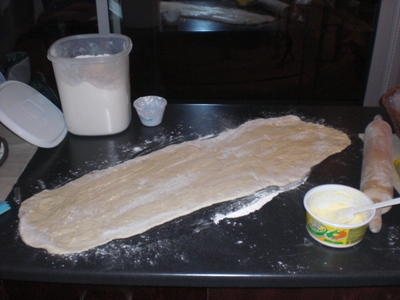
Photo: Cake ready for cutting the garland-pattern
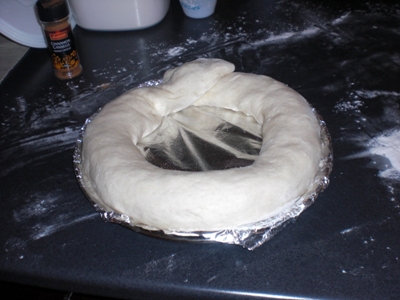
Photo: Cake with garland-pattern ready for baking.
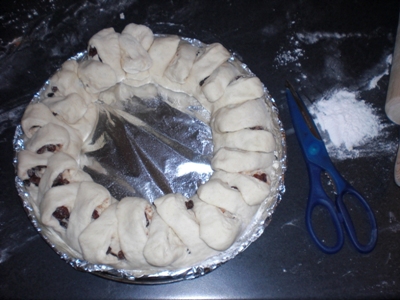
Sorry - no after-baking photo as we ate it before we got the camera out!
Posted by: Hild @ 6:03 pm
Initially our plan was to make calzone pizza, but then we remembered last time we made those. We made way too big calzones and ate them all…. piglets. So here is an option for a smaller dinner - maybe…
Ingredients (see also ‘Skulebrød’ - http://namnam.rygnestad.net/?p=28)
Dough for 6 horns:
- 20 grams butter (could also use 1/4 dl oil)
- 2.5 dl water (could also be milk)
- 1 rounded teaspoon dry yeast
- 1/2 teaspoon salt
- 1 teaspoon sugar
- ca. 6-7 dl of plain flour
- A little bit of milk for brushing
We like to not fill 2 horns and keep them for “afters” so - Filling for 4 horns (use whatever you’d like):
- 1/2 canned ham = 225 grams - chopped
- 3 rings of pineapple - drained well
- 1/4 red pepper - chopped
- 1/4 yellow pepper - chopped
- 12 table spoons cottage cheese (3 per horn) - drained well
Directions:
Follow the directions from ‘Skulebrød’ until the dough has risen once to approximately twice its original size. Divide the dough in two halves and roll it out. Cut three triangles from each half. Put some ham, pineapple, pepper, and cottage cheese at the wide end of each triangle. Fold the corners of each triangle around the filling and roll it up toward the pointy end of the triangle. [I know that this is cryptic - but the end result should look like a horn…]
Put the horns on a baking tray covered in aluminium foil and/or sprayed with oil. Cover the horns with a tea-towel and leave them to rise another 10-15 minutes. Turn on the oven and set it to 225 celsius. Bake the horns for 20-25 minutes in the middle of the oven.
Before serving, leave the horns on a rack to cool down. We ate them too soon and burned our mouths.
[This is where I would have added before- and after-photos, but the shutter speed on our camera is no match for Rob’s hunger. The horns were all gone before I could get a photo…. see: here is the empty plate!!]
